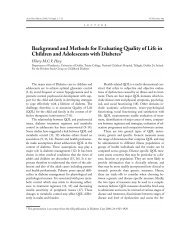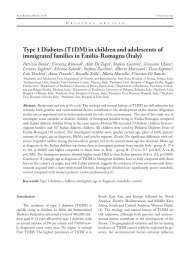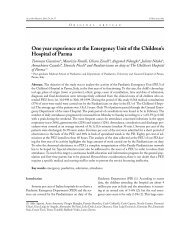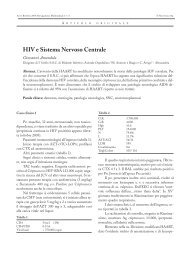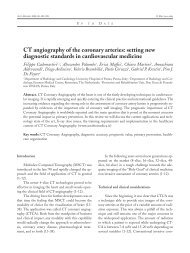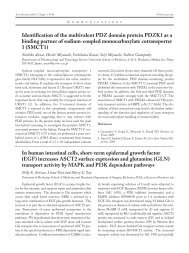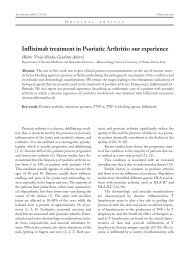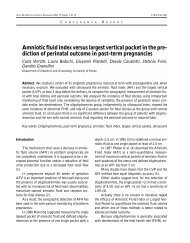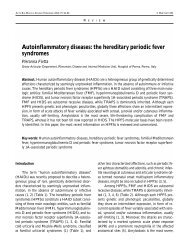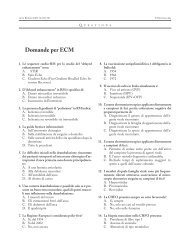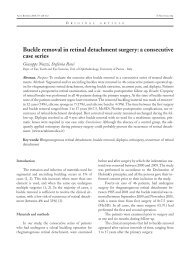Short reports+frontesp96-98 - Acta Bio Medica Atenei Parmensis
Short reports+frontesp96-98 - Acta Bio Medica Atenei Parmensis
Short reports+frontesp96-98 - Acta Bio Medica Atenei Parmensis
Create successful ePaper yourself
Turn your PDF publications into a flip-book with our unique Google optimized e-Paper software.
100 <strong>Short</strong> Reports<br />
20.2% hypocalcemia cases in cancers and 9.2% in benign<br />
diseases. Both persistant and transitory hypocalcemia<br />
incidence was higher in patients with hyperthyroidism<br />
than in euthyroid diseases. We didn’t find a<br />
statistically significative difference in hypocalcemia<br />
incidence, between patients who underwent operation<br />
for cancer and those for benign disease. Conclusions:<br />
We can conclude that hypocalcemia risk factors after<br />
thyroidectomy are hyperthyroidism and traumatic<br />
injuries caused by both lobes manipulation. Limitation<br />
of resection doesn’t reduce hypocalcemia risk factor.<br />
So to reduce hypocalcemia risk factors it is indispensable<br />
to minimise thyroid manipulation until parathyroid<br />
glandshave not been localised.<br />
The post-operatory antitrombotic prevention<br />
with physical headmasters in elderly patients<br />
M. Apperti, G. Lombardi, S.D. Ambrosio, A. Di Lucia, A.<br />
Masella<br />
University of Naples “Federico II”, Naples, Italy<br />
Study’s aims: The antitrombotic prevention with<br />
physical headmasters turns out necessary, above all in<br />
elderly patients and behaviours, but evaluating the timing<br />
of every single preventive therapy well is necessary,<br />
since these can turn out ineffective and then useless<br />
if you practise in moments make a mistake and<br />
with methodical wander. Materials and methods: What<br />
have been physical methodical holds in the principal<br />
one exam of antitrombotica prevention physical therapy,<br />
the elastocompression and the pneumatic compression.<br />
Have been compared the various characteristics,<br />
the advantages and the disadvantages, the effectiveness<br />
and above all, the physical headmasters’ ineffectiveness<br />
when is applied in wrong moments of the post<br />
operatory in the elderly subject. Turned out obtained:<br />
pointed out results the principal ones’ methodical uselessnesses<br />
of antitrombotica prevention in the post operatory<br />
of the elderly subject, if they are applied in way<br />
and wrong due of time physical therapy turns out of some<br />
effectiveness only during the sitting, leaving remarkable<br />
time “uncovered” spaces in which the antitrombotica<br />
prevention is absent. The immobility to bed<br />
of the patient limits the action of the elastocompression<br />
which only turns out effective if taken by active muscular<br />
movements, while the intermittent pneumatic compression<br />
turns out the choice therapy during the surgical<br />
intervention when the “muscular pump deficit” is<br />
absolute and the alterations of the vis to back and the<br />
vis against make concrete the risk to develop the trombotica<br />
illness. Conclusions: Therefore one thinks that an<br />
only ideal technique does not exist for the antitrombotica<br />
prophylaxis with physical headmasters, but that<br />
these go chosen in function of the knowledge of emodinamic<br />
in way which are direct in aimed way on the fisiopatologic<br />
mechanisms which at that specific moment<br />
increase the risk by developing the tromboembolica<br />
illness. Therefore one considers that the elastocompressione<br />
finds his choice indication in the post operatory<br />
period when the patient can perform active movements<br />
with the possible one as aid of physical therapy<br />
and the passive gymnastics, while instead the intermittent<br />
pneumatic compression is the methodical only one<br />
which up to now has shown a real effectiveness on the<br />
venous return during the surgical act.<br />
Gastro-intestinal angiodysplasia and multiple<br />
myeloma: description of a case and review of the<br />
literature<br />
C. Bonuso, R. D’Avino, N. Della Volpe, A. Caiazza, F.<br />
Leone<br />
Department of General Surgery, Geriatrics, Oncology and Advanced<br />
Technologies, University of Naples “Federico II”, Naples,<br />
Italy<br />
The decision to study this association stems from<br />
the case of a 73-year-old female patient with multiple<br />
myeloma who came to our observation following several<br />
days of fatigue and anemia due to loss of black<br />
tarry stools (melena). Esophagogastroduodenoscopy<br />
revealed non-bleeding angiodysplastic lesions to the<br />
duodenum, but did not explain the hemorrhage. A given<br />
capsule endoscopy was therefore performed, which<br />
confirmed the lesions described above and also evidenced<br />
signs of recent bleeding of the jejunum and<br />
ileum. Having demonstrated the cause of the melena,<br />
the Authors reviewed the literature in search of a possible<br />
link between angiodysplasia and monoclonal disease.<br />
Though no evidence was found of a direct correlation<br />
between the two diseases, it appears that mul-



